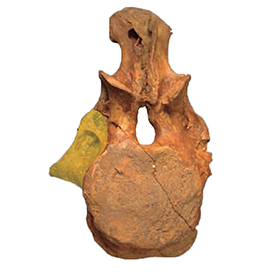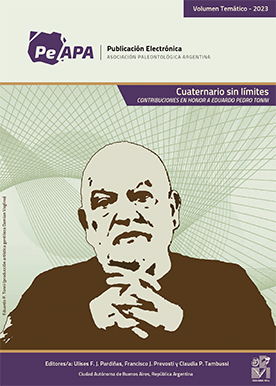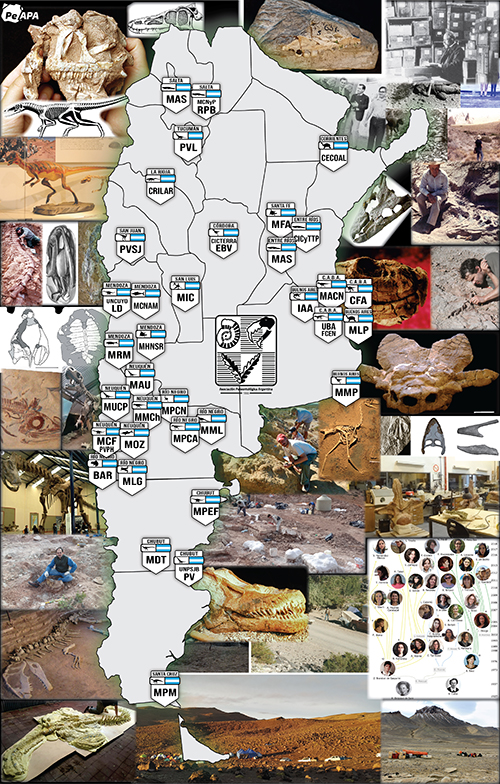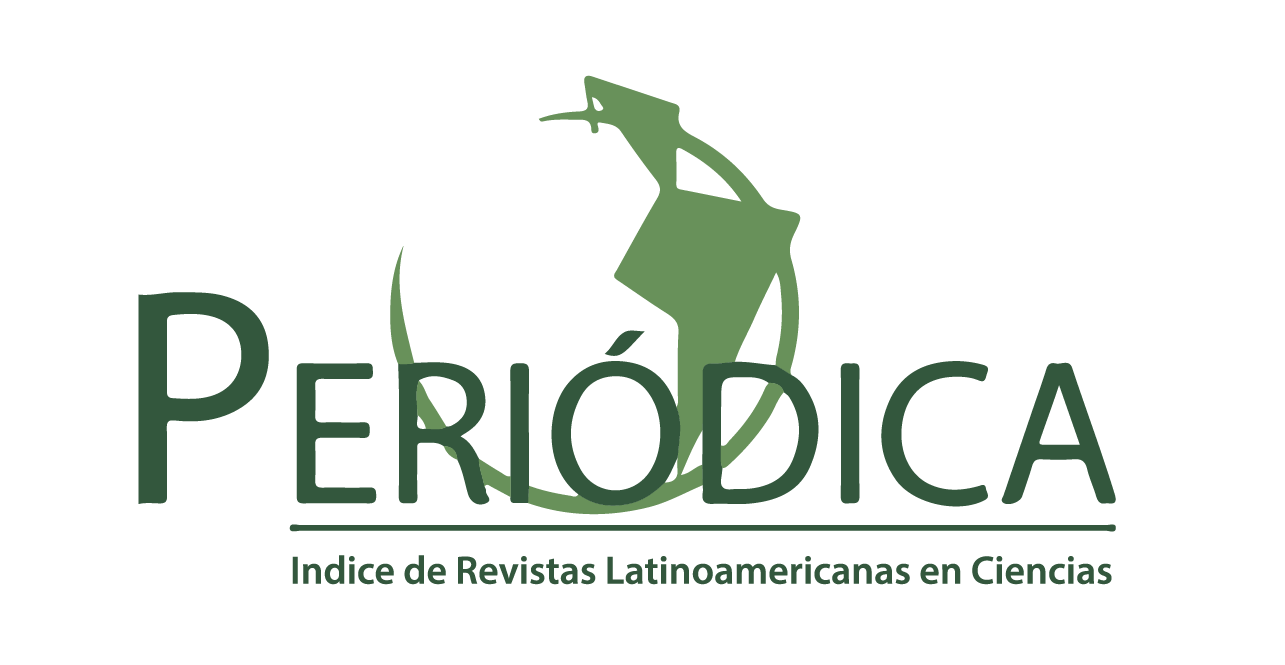¿SAURÓPODOS REBBAQUISÁURIDOS EN ASIA? UNA RE-EVALUACIÓN DE LA POSICIÓN FILOGENÉTICA DE DHARATITANIS KINGI DEL CRETÁCICO TARDÍO DE UZBEKISTÁN
DOI:
https://doi.org/10.5710//PEAPA.24.03.2021.389Palabras clave:
Dzharatitanis, Titanosauria, Cretácico, Rebbachisauridae, DinosauriaResumen
Una vértebra caudal aislada del Cretácico Tardío de Uzbekistán (Asia), previamente interpretada como una caudal anterior de titanosaurio, fue asignada recientemente como el holotipo y único espécimen de un nuevo rebaquisáurido, Dzharatitanis kingi. Este registro impacta drásticamente tanto en los aspectos biogeográficos como cronológicos del grupo. Como algunos de los caracteres identificados para dicha asignación sistemática parecen estar codificados incorrectamente y/o tener una distribución más amplia entre Neosauropoda, los mismos son revisados y discutidos en este trabajo con el fin de verificar las afinidades de este taxón con los rebaquisáuridos. Los análisis filogenéticos llevados a cabo recuperan a Dzharatitanis como un saurópodo titanosaurio, probablemente más relacionado a Lognkosauria. Los pasos extras necesarios para forzar Dzharatitanis dentro de Rebbachisauridae confirman sus afinidades con los titanosaurios, siendo esta no solo la hipótesis más parsimoniosa, sino que también está bien soportada cuando se tiene en cuenta la escasez del material. Dada esta nueva posición filogenética, aquí se proporciona una nueva diagnosis modificada. Aunque se necesita evidencia más completa, la reinterpretación de Dzharatitanis como un titanosaurio con afinidades a los lognkosaurios sugiere una distribución biogeográfica más amplia de este grupo de colossosaurios durante el Cretácico. Actualmente, no hay evidencia confiable para suponer que los saurópodos rebaquisáuridos hayan habitado Asia.
Referencias
Apesteguía, S. (2004). Bonitasaura salgadoi gen. et sp. nov.: a beaked sauropod from the Late Cretaceous of Patagonia. Naturwissenschaften, 91, 493–497.
Averianov, A. & Sues, H. D. (2021). First rebbachisaurid sauropod dinosaur from Asia. PloS ONE, 16(2), e0246620.
Borsuk-Bialynicka, M. (1977). A new camarasaurid sauropod Opisthocoelicaudia skarzynskii gen. n., sp. n. from the Upper Cretaceous of Mongolia. Palaeontologia Polonica, 37(5), 5–64.
Calvo, J. O., Porfiri, J. D., González Riga, B. J., & Kellner, A. W. A. (2007). Anatomy of Futalognkosaurus dukei Calvo, Porfiri, González Riga & Kellner, 2007 (Dinosauria, Titanosauridae) from the Neuquén Group (Late Cretaceous), Patagonia, Argentina. Arquivos do Museu Nacional, Rio de Janeiro, 65(4), 511–526.
Calvo, J. O. & Salgado, L. (1995). Rebbachisaurus tessonei sp. nov. a new Sauropoda from the Albian-Cenomanian of Argentina; new evidence on the origin of the Diplodocidae. Gaia, 11, 13–33.
Canudo, J. I., Carballido, J. L., Garrido, A. C., & Salgado, L. (2018). A new rebbachisaurid sauropod from the Lower Cretaceous (Aptian-Albian) of the Rayoso Formation (Neuquén, Argentina). Acta Palaeontologica Polonica 63(4), 679–691.
Carballido, J. L., Pol, D., Otero, A., Cerda, I. A., Salgado, L., Garrido, A. C., & Krause, J. M. (2017). A new giant titanosaur sheds light on body mass evolution among sauropod dinosaurs. Proceedings of the Royal Society B: Biological Sciences, 284(1860), 20171219.
Carballido, J. L., Salgado, L., Pol, D., Canudo, J. I., & Garrido, A. (2012). A new basal rebbachisaurid (Sauropoda, Diplodocoidea) from the Early Cretaceous of the Neuquén Basin; evolution and biogeography of the group. Historical Biology, 24(6), 631–654.
Carpenter, K. (2018). Maraapunisaurus fragillimus, ng (formerly Amphicoelias fragillimus), a basal rebbachisaurid from the Morrison Formation (Upper Jurassic) of Colorado. Geology of the Intermountain West, 5, 227–244.
Curry Rogers, K. & Forster, C. A. (2001). The last of the dinosaur titans: a new sauropod from Madagascar. Nature, 412(6846), 530–534.
Fanti, F., Cau, A., Cantelli, L., Hassine, M., & Auditore, M. (2015). New information on Tataouinea hannibalis from the Early Cretaceous of Tunisia and implications for the tempo and mode of rebbachisaurid sauropod evolution. PloS ONE, 10(4), e0123475.
Fernández-Baldor, F. T., Canudo, J. I., Huerta, P., Montero, D., Suberbiola, X. P., & Salgado, L. (2011). Demandasaurus darwini, a new rebbachisaurid sauropod from the Early Cretaceous of the Iberian Peninsula. Acta Palaeontologica Polonica, 56(3), 535–552.
Gallina, P. A. (2011). Notes on the axial skeleton of the titanosaur Bonitasaura salgadoi (Dinosauria-Sauropoda). Anais da Academia Brasileira de Ciências, 83(1), 235–246.
Gallina, P. A. & Apesteguía, S. (2005). Cathartesaura anaerobica gen. et sp. nov., a new rebbachisaurid (Dinosauria, Sauropoda) from the Huincul Formation (Upper Cretaceous), Río Negro, Argentina. Revista Museo Argentino Ciencias Naturales n.s., 7(2), 153–166.
Gallina, P. A. & Apesteguía, S. (2015). Postcranial anatomy of Bonitasaura salgadoi (Sauropoda, Titanosauria) from the Late Cretaceous of Patagonia. Journal of Vertebrate Paleontology, 35(3), e924957.
Gallina, P. A., Canale, J. I., & Carballido, J. L. (2021). The earliest known titanosaur sauropod dinosaur. Ameghiniana, 58(1), 35–51.
Gallina, P. A. & Otero, A. (2009). Anterior caudal transverse processes in sauropod dinosaurs: morphological, phylogenetic and functional aspects. Ameghiniana, 46(1), 165–176.
González Riga, B. J. G. (2003). A new titanosaur (Dinosauria, Sauropoda) from the Upper Cretaceous of Mendoza province, Argentina. Ameghiniana, 40(2), 155–172.
Ibiricu, L. M., Casal, G. A., Lamanna, M. C., Martínez, R. D., Harris, J. D., & Lacovara, K. J. (2012). The southernmost records of Rebbachisauridae (Sauropoda: Diplodocoidea), from early Late Cretaceous deposits in central Patagonia. Cretaceous Research, 34, 220–232.
Kellner, A. W. A., Campos, D. D. A., & Trotta, M. N. (2005). Description of a titanosaurid caudal series from the Bauru Group, Late Cretaceous of Brazil. Arquivos do Museu Nacional, 63(3), 529–564.
Lerzo, L. N., Carballido, J. L., & Gallina, P. A. (2021). Data from Rebbachisaurid sauropods in Asia? A re-evaluation of the phylogenetic position of Dzharatitanis kingi from the Late Cretaceous of Uzbekistan. In Morphobank. https://morphobank.org/permalink/?P3973
Lindoso, R. M., Medeiros, M. A. A., de Souza Carvalho, I., Pereira, A. A., Mendes, I. D., Iori, F. V., & Silva, T. C. M. (2019). A new rebbachisaurid (Sauropoda: Diplodocoidea) from the middle Cretaceous of northern Brazil. Cretaceous Research, 104, 104191.
Lü, J., Xu, L., Jiang, X., Jia, S., Li, M., Yuan, C., & Ji, Q. (2009). A preliminary report on the new dinosaurian fauna from the Cretaceous of the Ruyang Basin, Henan Province of central China. Journal of the Paleontological Society of Korea, 25(1), 43–56.
Mannion, P. D. & Barrett, P. M. (2013). Additions to the sauropod dinosaur fauna of the Cenomanian (early Late Cretaceous) Kem Kem beds of Morocco: palaeobiogeographical implications of the mid–Cretaceous African sauropod fossil record. Cretaceous Research, 45, 49–59.
Mannion, P. D., Upchurch, P., & Hutt, S. (2011). New rebbachisaurid (Dinosauria: Sauropoda) material from the Wessex Formation (Barremian, Early Cretaceous), Isle of Wight, United Kingdom. Cretaceous Research, 32(6), 774–780.
Pereda Suberbiola, X., Torcida, F., Izquierdo, L. A., Huerta, P., Montero, D., & Perez, G. (2003). First rebbachisaurid dinosaur (Sauropoda, Diplodocoidea) from the early Cretaceous of Spain: palaeobiogeographical implications. Bulletin de la Société géologique de France, 174(5), 471–479.
Rauhut, O. W., Carballido, J. L., & Pol, D. (2015). A diplodocid sauropod dinosaur from the Late Jurassic Cañadón Calcáreo Formation of Chubut, Argentina. Journal of Vertebrate Paleontology, 35(5), e982798.
Sues, H. D., Averianov, A., Ridgely, R. C., & Witmer, L. M. (2015). Titanosauria (Dinosauria, Sauropoda) from the Upper Cretaceous (Turonian) Bissekty Formation of Uzbekistan. Journal of Vertebrate Paleontology, 35(1), e889145.
Tschopp, E., Mateus, O., & Benson, R. B. (2015). A specimen-level phylogenetic analysis and taxonomic revision of Diplodocidae (Dinosauria, Sauropoda). PeerJ, 3, e857.
Upchurch, P. & Mannion, P. D. (2009). The first diplodocid from Asia and its implications for the evolutionary history of sauropod dinosaurs. Palaeontology, 52(6), 1195–1207.
Whitlock, J. A. (2011). A phylogenetic analysis of Diplodocoidea (Saurischia: Sauropoda). Zoological Journal of the Linnean Society, 161(4), 872–915.
Whitlock, J. A., D’Emic, M. D., & Wilson, J. A. (2011). Cretaceous diplodocids in Asia? Re‐evaluating the phylogenetic affinities of a fragmentary specimen. Palaeontology, 54(2), 351–364.
Whitlock, J. A. & Wilson-Mantilla, J. A. (2020). The Late Jurassic sauropod dinosaur ‘Morosaurus’ agilis Marsh, 1889 reexamined and reinterpreted as a dicraeosaurid. Journal of Vertebrate Paleontology, e1780600.
Wilson, J. A. & Allain, R. (2015). Osteology of Rebbachisaurus garasbae Lavocat, 1954, a diplodocoid (Dinosauria, Sauropoda) from the early Late Cretaceous–aged Kem Kem beds of southeastern Morocco. Journal of Vertebrate Paleontology, 35(4), e1000701.
Xu, X., Upchurch, P., Mannion, P. D., Barrett, P. M., RegaladoFernandez, O. R., Mo, J., & Liu, H. (2018). A new Middle Jurassic diplodocoid suggests an earlier dispersal and diversification of sauropod dinosaurs. Nature communications, 9(1), 1–9.

Descargas
Publicado
Número
Sección
Licencia

Los/las autores/as conservan los derechos de autor/a y garantizan a la revista el derecho de ser la primera publicación del trabajo licenciado bajo una licencia CC Attribution-NonCommercial 4.0 que permite a otros/as compartir el trabajo con el reconocimiento de la autoría y de la publicación inicial en esta revista.




















